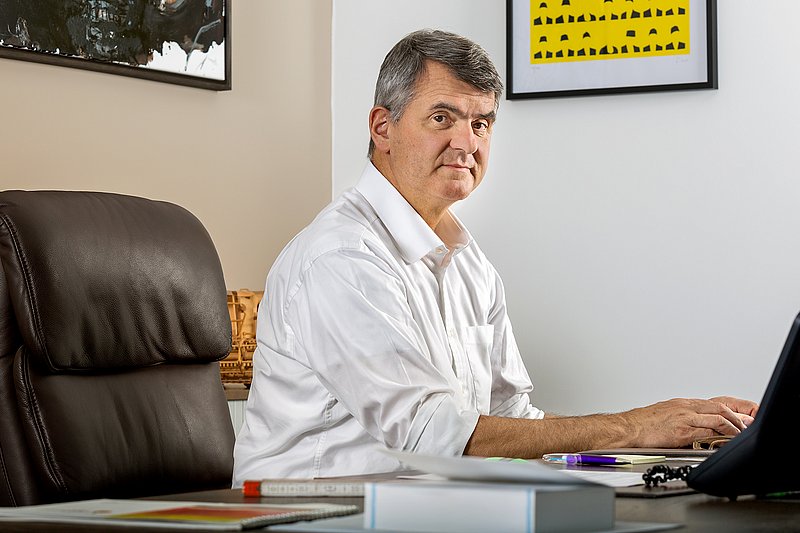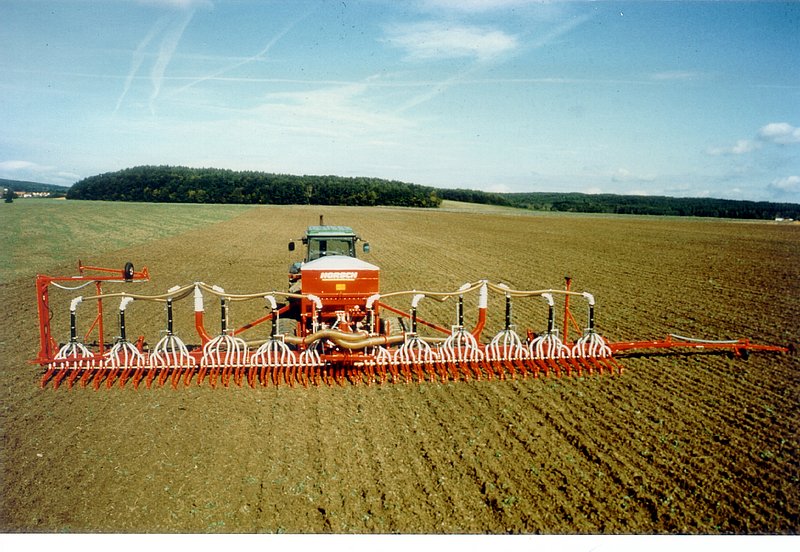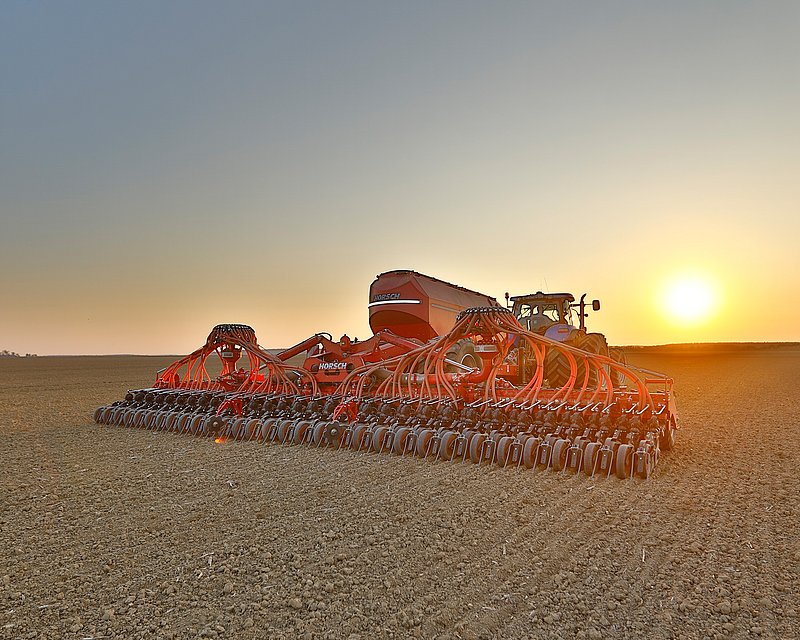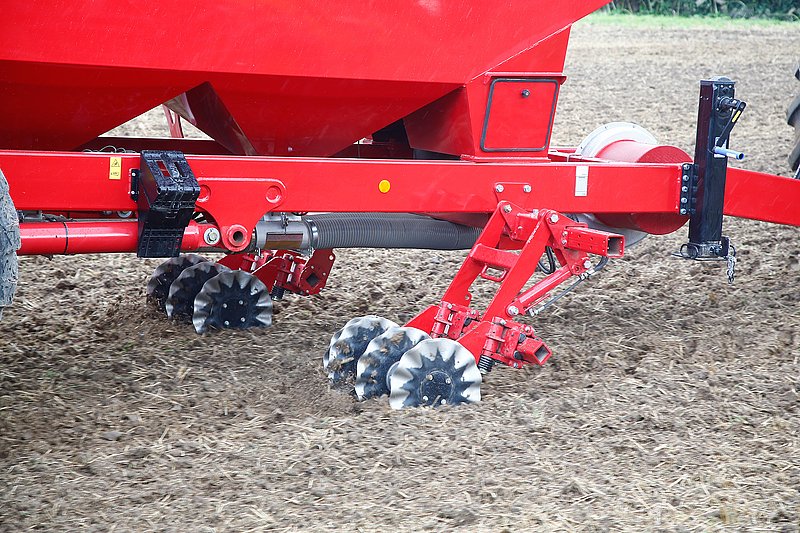Conventional seeding – then and now
At the beginning of the 1990s, the offset sowing method was very common in East Germany. In the meantime, conventional seeding is making its comeback. Michael Horsch explains the reasons.

terraHORSCH: Mister Horsch, what can you tell us about the beginnings of the offset sowing system?
Michael Horsch: At the beginning of the 1990s, we sold some PD 12 seed drills in East Germany. At that time, the PD 12 was the first pneumatic HORSCH seed drill with more than 12 m working width and at the same time one of the largest seed drills on the European market.

The standard tractor then was 180 hp and was perfectly suitable to pull a PD 12. The soil, however, had to be prepared intensely in advance and with mulch seed it was not that easy. On light soils it worked well, but on heavier soils it was considerably more difficult and two to three seedbed preparation passes had to be carried out in advance. This required two to
three additional tractors – only to prepare the seedbed. Including the seed drill, you always needed three to four tractors. The sowing quality was – because of the light drag coulters and depending on the seedbed preparation – sometimes better and sometimes worse. The end of conventional seeding was signalled by mulch seeding which was becoming more and more popular. At the same time, the first tractors with 250 hp were launched. They allowed for carrying out stubble cultivation and shallow cultivation with 6 m working width. Moreover, the marketing of the first tine seed drills and after some time of the disc seed drills started.
At the beginning of the 2000s, the power of the tractors rose from 250 hp to 300 hp. As a result, the working widths continued to increase and in the tillage sector machines with 6 to 8 m working width came on the market. For seeding we launched the combi seed drill HORSCH Pronto. It was a huge success. It did not only produce the final fine earth, but also allowed for seeding precisely in changing soil conditions and with varying preparation. Due to the larger tractors and the HORSCH Pronto the farmers were able to use only one tractor for seedbed preparation and sowing – with a quality that had not been possible before and a very high hectare output.
At the same time, the launch of compact disc harrows increased and the tine spacing of the cultivators became narrower: from 30 cm down to 20 cm. Consolidation technology with rollers and packers and so on were further optimised.
How did it continue in the 2010s?
Michael Horsch: Around 2010 the power of the tractors slowly approached 350 hp and the working width of the HORSCH Pronto increased to 9 m. For larger farms it became more and more difficult to find qualified staff to handle the working peaks that became shorter and shorter in due time. This was the reason why we increased the working width of the HORSCH Pronto to 12 m. The problem, however, was that even the 400 hp tractors were not powerful enough to pull a HORSCH Pronto 12 SW. 500 to 600 hp were required to do so. Only some farmers were willing – just to pull the seed drill – to purchase another tractor of this size. And 25-ton-tractors in front of a seed drill in already intensely cultivated fields are too much anyway! We had to look into a basic change of the system. On the one hand, the objective was to sow faster and faster, but on the other hand, there was less staff on the farms and the workload continued to rise.
What were the first steps of this change of system?
Michael Horsch: Five years ago we started on our own farm AgroVation to introduce “Controlled Traffic Farming” (CTF) with 12 m working width on all fields. But the problem was that a Pronto 12 SW consisting of a seed wagon and a trailed 12-m-Pronto was too long and too unwieldy. Our idea was to modify an existing maize planter Maestro with a heavy disc coulter in parallelogram version to be able to sow cereals with a width of 12 m. This worked quite well, only the seed placement in changing soil conditions partly was unsatisfactory. We should have known that beforehand, for even a parallelogram disc coulter with a press wheel behind it cannot level soil uneven ness’s and a different surface density. Already 20 years ago we worked this out during the development of our Pronto where a one-arm double disc coulter sows into a band that had been consolidated before – a sowing system that is copied extremely often all over the world and that today still is very successful. As a summary we can say that with our heavy parallelogram coulter we had the right placement technology even if the seedbed sometimes is a little bit coarse. However, the seed drill without a front tyre packer like the Pronto could not meet our requirements for an even sowing depth. The result of these findings was the Serto SC: compact folding like a Maestro SW, with fully-fledged tyre packer and the newly developed PowerDisc parallelogram coulter.

What are the advantages of the conventional system today?
Michael Horsch: Today the standard tractors are in a range of about 400 hp. Even a 12-m-Joker or a 12-m-Cruiser can be pulled with 400 hp for seedbed preparation. A lot of large farms, however, also have a tractor with up to 600 hp which can be used for seedbed preparation in more difficult conditions. So you cannot only prepare the field with 12 m working width, but you can also sow with a 12m wide HORSCH Serto. For both passes 12 to 15 km/h are an optimum speed. Thus, it is possible to manage a daily output of 100 to 200 ha when sowing cereals/rape with two times 400 PS in an optimum way. And all this – as our own experience shows – on fields with a size of 10 to 20 ha. This kind of conventional seeding also allows for reacting individually to very wet or extremely dry conditions – with the timing of the preparatory works and the choice of the seedbed preparation technology like Joker or Cruiser.
Another important topic one has to pay attention to is the track of the tractor that pulls the Serto. The wavy disc system removes the tractor track even at high speeds. But it still is important that the tractor is equipped with adequate tyres and is not too heavy.

In this case the CTF system where the tractor for seedbed preparation and the tractor for the Serto drive in the same track is a good choice. Together with Prof. Dr. Bauer from the university in Triesdorf we are currently working out exactly which yield advantages result from this system.
Why are especially large farms thrilled by the conventional seeding method?
Michael Horsch: The main reason is the high hectare output combined with an optimum work quality. But the Serto also convinces by very quick and compact folding and a safe readability. Another reason are that the 12m Joker or Cruiser machines that require only low horsepower as of 400 hp – if you want to adapt to all sowing conditions, you will need both machines. And: If glyphosate will be banned, the conventional method is a must. For how else can you remove light green vegetation before sowing than by cultivating it and letting it dry off shortly before sowing? The advantages of the Serto SC are compact design, simple handling and robustness. In case of a glyphosate ban there is no way getting around an conventional system. And it also is a solution if you voluntarily choose to do without glyphosate. If we want to increase precision even further, we have to talk about the coulter step – especially on free-flowing soils. To get more clearance in the area of the seed coulters, they are arranged in two rows. Thus, more earth and harvest residues can flow through the seed coulters. The disadvantage on free-flowing soils: The earth of the second row of seed coulters meets the already sown first row. Seed depth differences might result. This effect may be eliminated by equally long coulters. However, especially on heavier soils the field has to be prepared in an optimum and fine way to avoid blockages. We see a clear demand on the market to further concentrate on the topic of precision when sowing.
What do farmers have to pay attention to if they at the same time want to use a hoe on their fields?
Michael Horsch: We currently are focussing on hoeing and harrowing technology. The expansion of organic farming and the increasing willingness of conventional farms – keyword: hybrid farming – to look into mechanical population care measures are the reasons why the demand for such machines increases considerably. If the crop is to be hoed, in addition to a sufficient row spacing of 25 to 35 cm, special attention has to be paid to regular spacings. In this respect the design of the seed coulters in one row we already mentioned – or in other words equally long coulters – may become a key factor. No matter if on level land or on slopes – the row spacings always remain regular as they cannot converge. At the moment, we are gathering quite positive experiences with our Avatar 12.25 SD. 25 cm row spacing, 1-bar design and large working widths are ideal for hoeing. Thus, all requirements with regard to the seed drill have been met.
What do you have to observe for the conventional method with regard to tyre pressure and working width?
Michael Horsch: It is important to pay attention to the ratio of rolling surface to non-rolling surface, plus the tyre profile and the total weight of the machine.
One of the basic principles of conventional seeding is to keep the track ratio as low as possible. The conclusion that can be drawn is that the offset system only makes sense for larger working widths. At the moment, we are offering machines with 10 m and 12 m working width. But we also think about providing machines with a working width as of 8 m. Beside the track ratio the track itself has an enormous influence. It is important to work with the optimum tyre pressure or to use tractors with power tracks as an alternative.